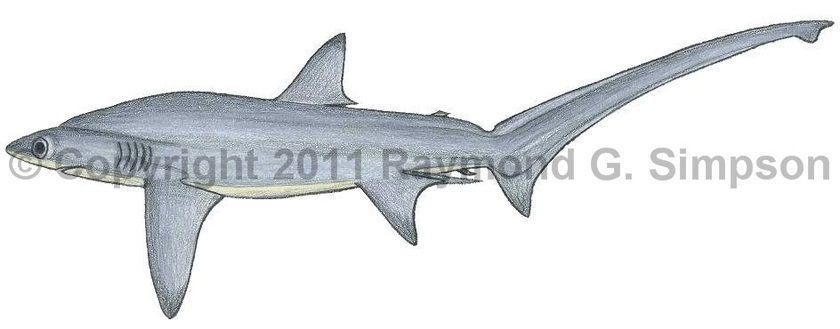
Common Name
Bigeye Thresher
Year Described
Lowe, 1839
Identification
Elongate and fusiform, with an extremely long upper caudal lobe. Head very small, with a very large eye (extending onto top of head) and a long snout. Top of head flat behind the eye. There are deep grooves running from behind the eye to the upper gill area. Labial furrows are absent. Teeth number 11-12/12 upper rows and 10-12/12 lower rows. Teeth are small with angled triangular cusps posteriorly; larger in upper jaw. Dorsal fin quite high with the origin closer to pelvic fin than pectoral fin. Pectoral fin large and bluntly pointed. Second dorsal and anal fins tiny. Pelvic fin abdominal and quite large. Dermal denticles small and barely overlapping, with single points.
Color
Dorsal midline and head groove dark brown, gray or black. A broad area of the flank is pale blue to gray with a strong metallic purple or golden sheen in living specimens. The belly is whitish. Fins are the color of the dorsum.
Size
Maximum size to over 400cm TL. Males mature at around 300cm TL and females at closer to 350cm TL. Newborns are around 140cm TL.
Habitat
Pelagic from continental waters to the open ocean (0-500m). Appears to stay deep during the day and moves toward the surface at night.
Range
Cape Cod to S. Brazil, including the Caribbean Sea and the Gulf of Mexico. More widespread in the tropics.
References
Castro, J.I. 2011. The Sharks of North America. Oxford University Press, 640 pp.
Compagno, L.J.V. 2002. Sharks. In: Carpenter, K.E. (Editor) FAO Identification Guide for Fishery Purposes. The Living Marine Resources of The Western Central Atlantic. Volume 1: Introduction, mollusks, crustaceans, hagfishes, sharks, batoid fishes, and chimaeras. ASIH Special Publication No. 5. FAO, Rome.
Compagno, L., M. Dando, and S. Fowler. 2005. Sharks of the World. Princeton University Press, 480 pp.